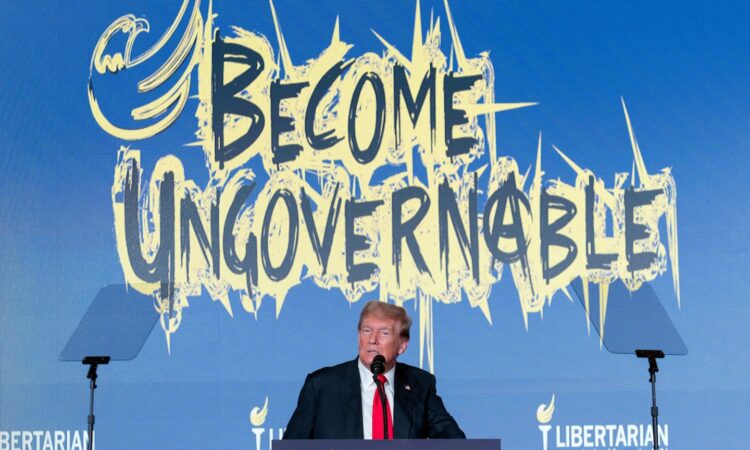
That’s the important point here, but let’s first offer the longer answer, explaining what Trump was saying and why.
The post at issue linked to an essay in Bitcoin magazine written by a former communications staffer from Trump’s administration. It suggested that Trump was “the best choice for bitcoin,” which Trump’s post amplified.
“VOTE FOR TRUMP! Bitcoin mining may be our last line of defense against a CBDC,” it read. “Biden’s hatred of Bitcoin only helps China, Russia, and the Radical Communist Left. We want all the remaining Bitcoin to be MADE IN THE USA!!! It will help us be ENERGY DOMINANT!!!”
A “CBDC” is a central bank digital currency, a government-issued cryptocurrency. The idea is anathema to many bitcoin advocates, given their embrace of cryptocurrency as an alternative to government-backed currencies. Trump, in a bid to appeal to crypto enthusiasts, has taken up the cause — at least, as part of his stump speech.
“I will never allow the creation of a central bank digital currency,” Trump has said (in one form or another) a half-dozen times in speeches this year, including during remarks at the anti-government Libertarian Party convention. The denunciation generally comes in a list of campaign pledges he’s reading from the teleprompter.
This was not an issue when he was president. In fact, he excoriated cryptocurrencies specifically in 2019, saying that he was “not a fan” and that the currencies could “facilitate unlawful behavior.”
I am not a fan of Bitcoin and other Cryptocurrencies, which are not money, and whose value is highly volatile and based on thin air. Unregulated Crypto Assets can facilitate unlawful behavior, including drug trade and other illegal activity….
— Donald J. Trump (@realDonaldTrump) July 12, 2019
But now he wants “all the remaining Bitcoin to be made in the USA,” which is like declaring that you want all the remaining animated feature films to be made in the USA: If people in other places have computers, they’re going to have a shot at mining bitcoin.
Bitcoin mining isn’t real mining, obviously. It’s a term of art used to describe the efforts to solve complicated mathematical equations, with users who solve the equations earning bitcoin as a reward. This isn’t pen-and-paper equation-solving but computational, so the effort to solve the equations requires an enormous amount of computing power — and, by extension, electricity. This, apparently is why Trump says a focus on bitcoin mining would make the United States “energy dominant,” though it’s a bit like saying that using a much higher percentage of the world’s gasoline would make us fossil-fuel dominant.
Trump’s effort to appeal to the cryptocurrency community isn’t surprising given how young and male that community skews. That broader constituency is one that Trump has been targeting for some time.
Polling conducted by YouGov earlier this year reflected that younger Americans and men were more likely to have heard a lot about cryptocurrency.
Men were also more likely to have invested in cryptocurrency, though this constituency skewed slightly older.
But hearing about cryptocurrency and having confidence in it are two different things. About three-quarters of Americans, including young Americans, indicated that they thought at least half of cryptocurrency companies were outright scams.
At Axios, Trump’s promotion of cryptocurrency, including his introduction of a line of NFTs in 2022, was framed as part of his effort to appeal to younger voters. But this brings us back to the initial point: His proposals tend to follow indications of support rather than drive them. (The NFTs, meanwhile, were pretty clearly a pure money play.)
Data from Gallup shows that younger, Black and Hispanic Americans have drifted right, particularly since 2020. This isn’t reflected strongly in voter registration data analyzed by Pew Research Center, but it is something Trump and his allies have picked up on. So his campaign tries to press its perceived advantage.
The campaign and its allies tend to present the causation backward, too. After Trump was processed following his indictment in Georgia, for example, his mug shot was hailed by conservative pundits as driving new Black support for his candidacy. There was no evidence of that. In June 2023, YouGov measured Trump’s support among Black voters at 15 percent. The mug shot was in August of that year. A recent YouGov poll had Trump at a statistically similar 12 percent.
Polls do show younger voters as more divided on the contest between Trump and President Biden than was reflected in 2020 exit polling. But that’s been the case for some time; younger voters were among the first constituencies to sour on Biden’s presidency. The trend began well before someone on Trump’s team slipped his denunciation of central bank cryptocurrencies into his stump speech.
The question, of course, is what happens on Election Day. Polling also suggests that Biden has a wider advantage among the most likely voters, including among younger Americans. The Harvard Youth Poll, released in April, showed that effect dramatically.
Trump’s social-media post about bitcoin reflects an effort to appeal to cryptocurrency advocates even as it conveys some lack of familiarity with the community. It seems safe to assume that the endorsement is less about broadly appealing to young voters than trying to lock up a favorable voting bloc, however modest. It’s also about once again positioning Trump as the outsider, the guy willing to take on the establishment in all of its manifestations.
He spent decades trying to close the deal in New York City real estate transactions. This post about bitcoin can probably best be read as an effort to sweeten the deal for a customer that he hopes is just about to put pen to paper.






